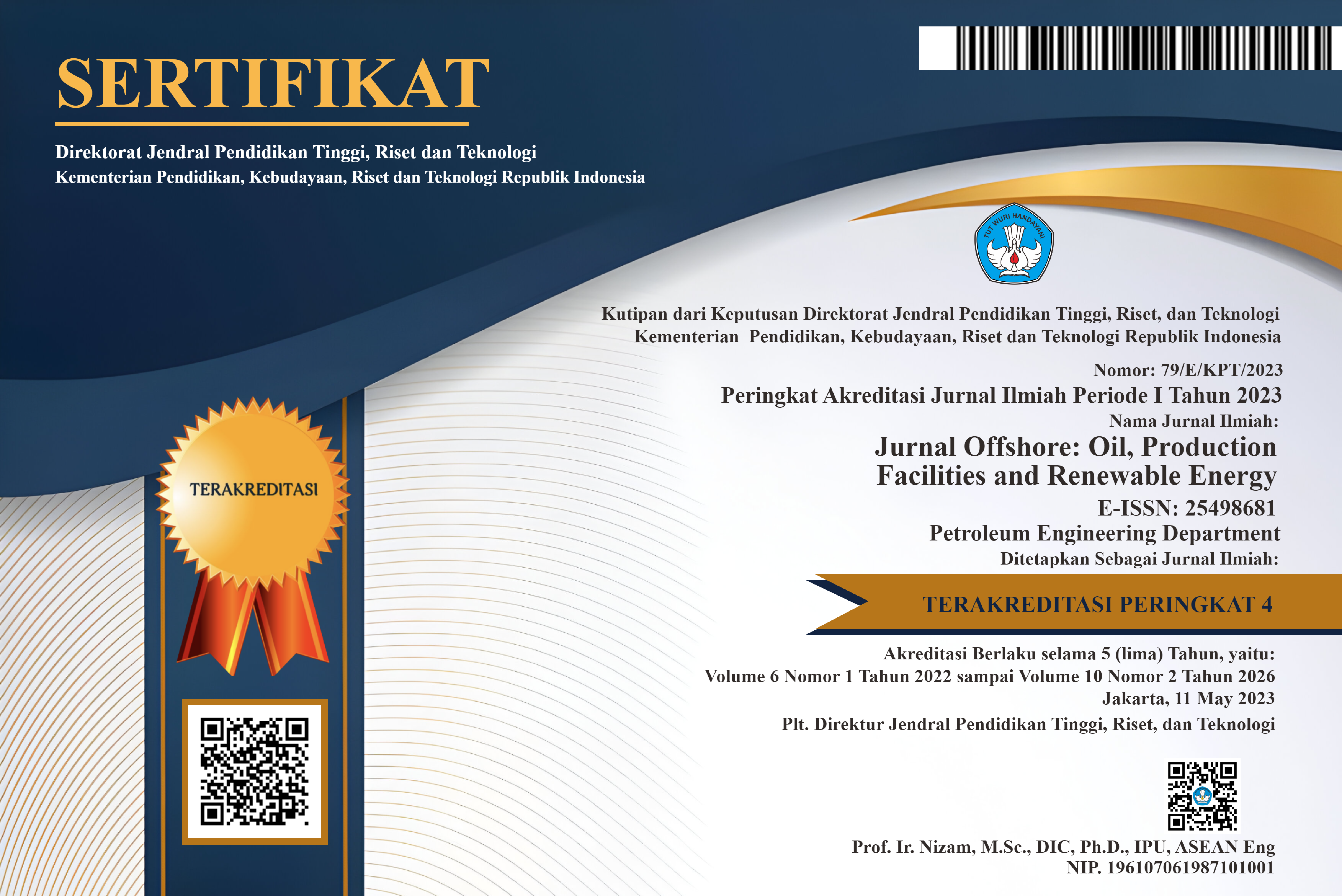Proses Gasifikasi Limbah Padat Aren Menggunakan Fixed-Bed Updraft Gasifier dengan Variasi Jenis Bahan
DOI:
https://doi.org/10.30588/jo.v2i2.400Keywords:
gasifikasi, limbah padat aren, fixed-bed updraft gasifier, syn gas, jenis bahan, gasification, areca solid waste, type of materialAbstract
Salah satu potensi sumber energi di Indonesia adalah limbah biomasa berupa limbah padat industri aren. Tujuan penelitian ini adalah untuk mengetahui pengaruh jenis bahan terhadap suhu reaktor dan efisiensi proses gasifikasi limbah padat aren. Bahan baku yang digunakan didapatkan dari Sentra Industri Tepung Aren di Dusun Daleman, Kecamatan Tulung, Kabupaten Klaten. Sebelum diproses bahan dikeringkan terlebih dahulu dengan dijemur di bawah sinar matahari selama sehari, kemudian dilakukan analisa proksimat. Variabel penelitian adalah jenis bahan berupa limbah padat aren murni, campuran limbah padat aren dan tempurung kelapa, serta tempurung kelapa murni. Proses gasifikasi diawali dengan memasukkan bahan ke dalam reaktor tipe Fixed-bed Updraft Gasifier, kemudian dinyalakan sampai keluar gas yang bisa terbakar dan diuji selama satu jam. Syn gas yang terbentuk dianalisa kandungan gasnya, kemudian dibakar untuk mengetahui efisiensinya. Hasil penelitian menunjukkan bahwa jenis bahan mempengaruhi suhu proses di dalam reaktor, dimana suhu optimal dicapai pada gasifikasi tempurung kelapa murni, yaitu proses pengeringan pada suhu 120 °C, pirolisis 340 °C, Reduksi 650 °C, dan oksidasi 721 °C. Gas yang dihasilkan tersebut dapat terbakar selama 15 menit, dibandingkan campuran limbah padat aren - tempurung yang terbakar 8 menit dan limbah padat aren murni yang hanya mampu terbakar 1 menit.
One of the potential energy sources in Indonesia is biomass waste in the form of palm sugar solid waste. The purpose of this study was to determine the effect of the type of material on the reactor temperature and the efficiency of the sugar palm solid waste gasification process. The raw materials used were obtained from the Palm Sugar Flour Industrial Center in Daleman Hamlet, Tulung District, Klaten Regency. Before processing the material is first dried by drying it in the sun for a day, then proximate analysis is done. The research variable is the type of material in the form of pure sugar palm solid waste, a mixture of palm sugar solid waste and coconut shell, and pure coconut shell. The gasification process is initiated by inserting the material into the Fixed-bed Updraft Gasifier type reactor, then igniting the flammable gas and testing it for one hour. The syn gas formed is analyzed for its gas content, then burned to find out its efficiency. The results showed that the type of material influences the process temperature inside the reactor, where the optimum temperature is achieved in pure coconut gas gasification, namely the drying process at 120 °C, pyrolysis 340 °C, Reduction 650 °C, and oxidation 721 °C. The resulting gas can burn for 15 minutes, compared to a mixture of aren solid waste - shells that burn for 8 minutes and pure aren solid waste that can only burn for 1 minute.
References
Cahyono, M.S. 2013. Pengaruh Jenis Bahan pada Proses Pirolisis Sampah Organik menjadi Bio-Oil sebagai Sumber Energi Terbarukan. Jurnal Sains dan Teknologi Lingkungan Volume 5, Nomor 2, Juni 2013 Hal. 67-76.
Higman, C, And Van Der Berg, M. 2003. Gasification, Elsevier Science, USA
Pranolo, H 2010. Potensi Penerapan Teknologi Gasifikasi Tongkol Jagung Sebagai Sumber Energi Alternatif Di Pedesaan, Dalam Seminar Nasional Energi Terbarukan Indonesia di Universitas Jendral Sudirman Purwokerto.
Purwantana, B., An Nurisi, M., Markumning-sih, S., 2010. Kinerja Gasifikasi Limbah Padat Tebu (Saccharum Officinarum L.) Menggunakan Gasifier Unggun Tetap Tipe Downdraft
Sudarsono, dkk. 2013. Pemanfaatan Limbah Serat Pati Organik sebagai Material Komposit Poliester. Laporan penelitian hibah bersaing Institut Sains & Teknologi AKPRIND Yogyakarta. November 2013.
Downloads
Published
How to Cite
Issue
Section
License
Authors retain copyright and grant the Jurnal Offshore right of first publication with the work simultaneously licensed under a Creative Commons Attribution 4.0 International License that allows others to share (copy and redistribute the material in any medium or format) and adapt (remix, transform, and build upon the material) the work for any purpose, even commercially with an acknowledgement of the work's authorship and initial publication in Jurnal Offshore. Authors are able to enter into separate, additional contractual arrangements for the non-exclusive distribution of the journal's published version of the work (e.g., post it to an institutional repository or publish it in a book), with an acknowledgement of its initial publication in Jurnal Offshore. Authors are permitted and encouraged to post their work online (e.g., in institutional repositories or on their website) prior to and during the submission process, as it can lead to productive exchanges, as well as earlier and greater citation of published work (See The Effect of Open Access).
















